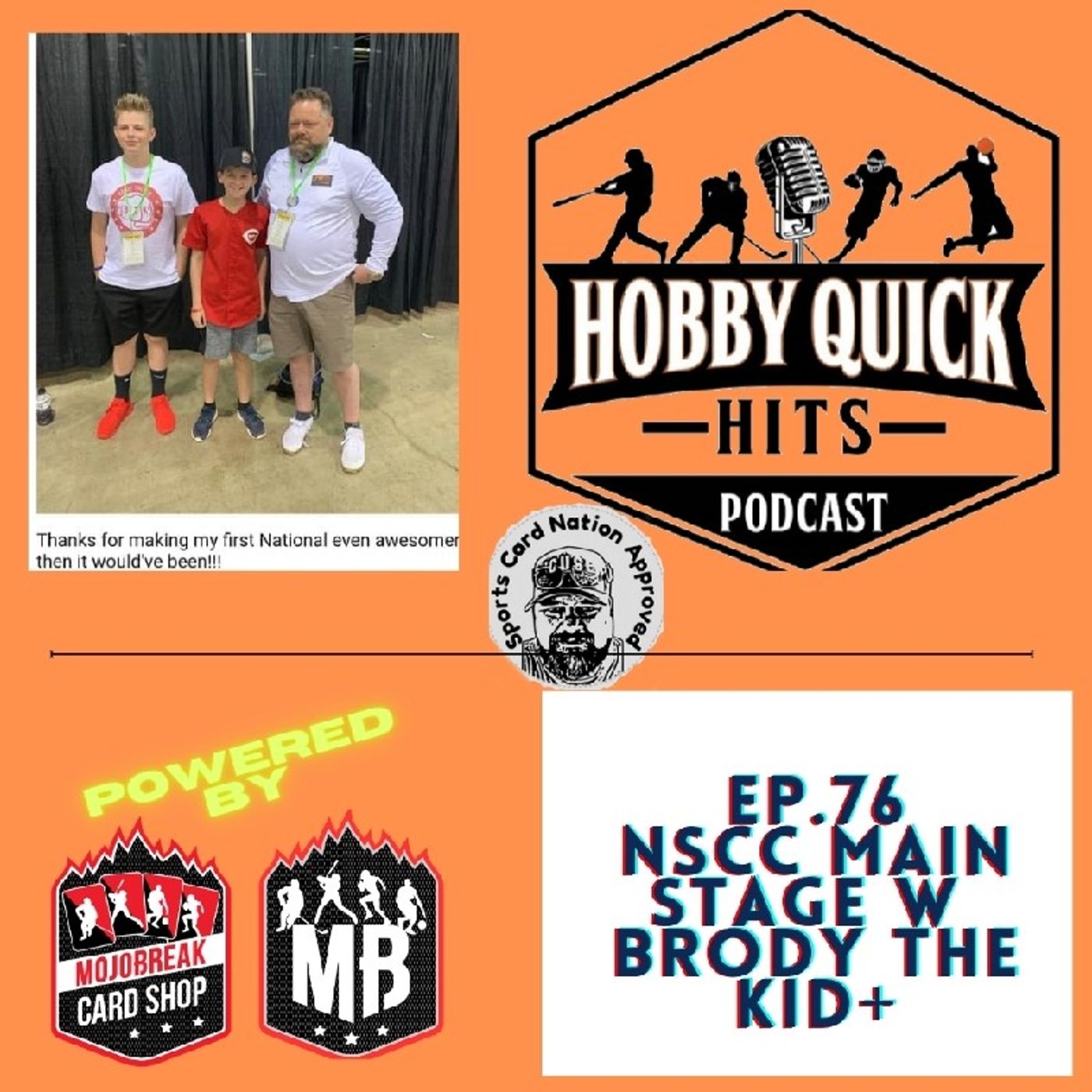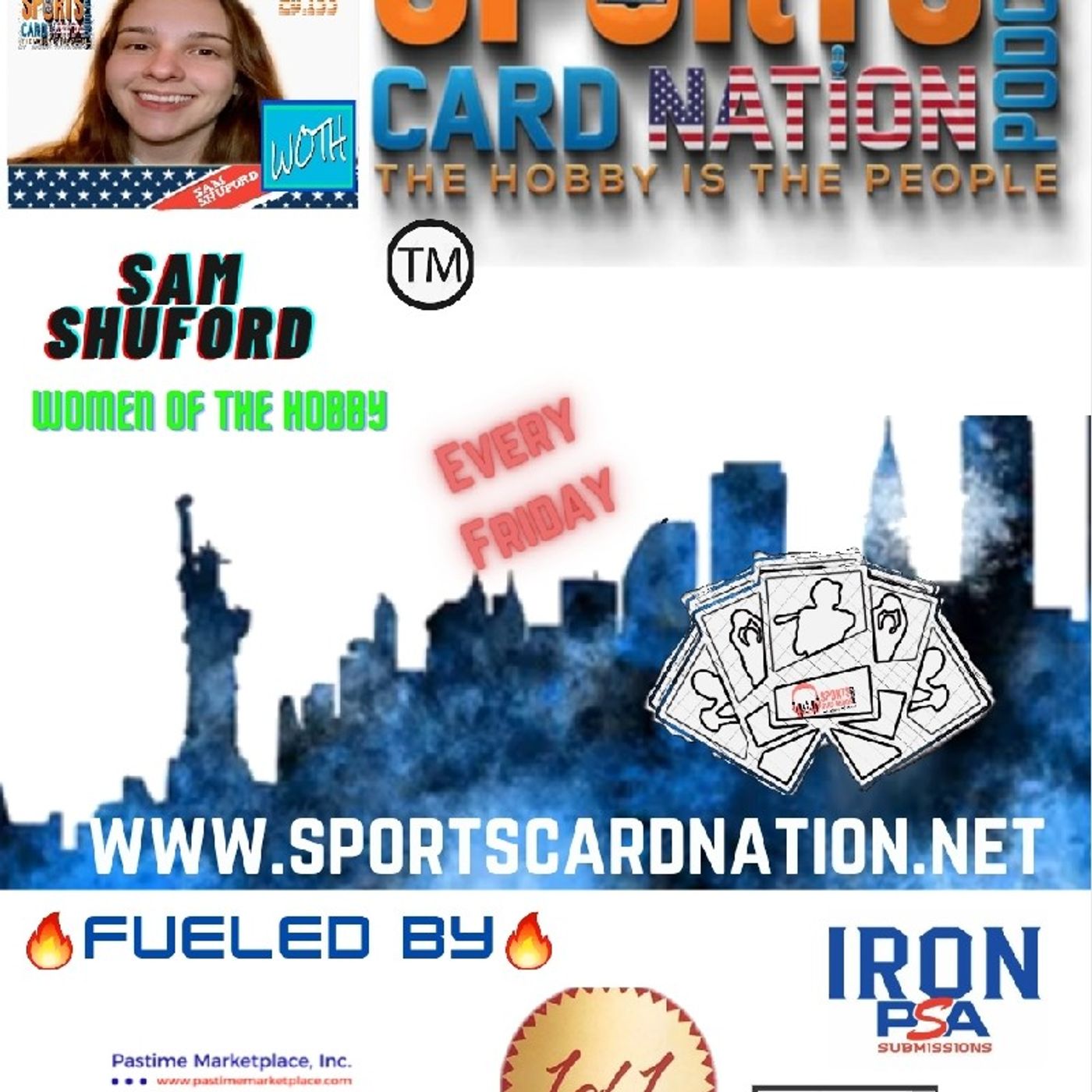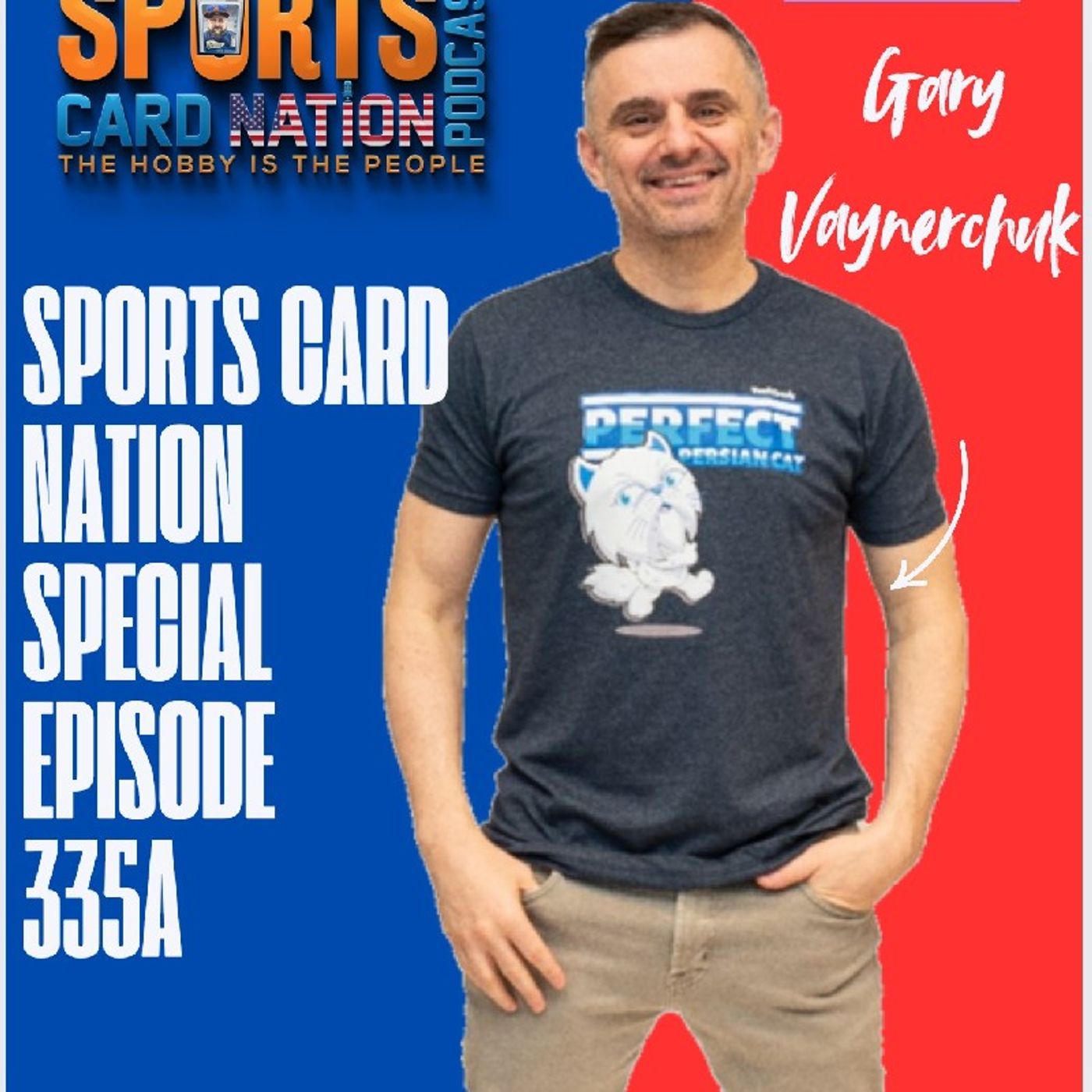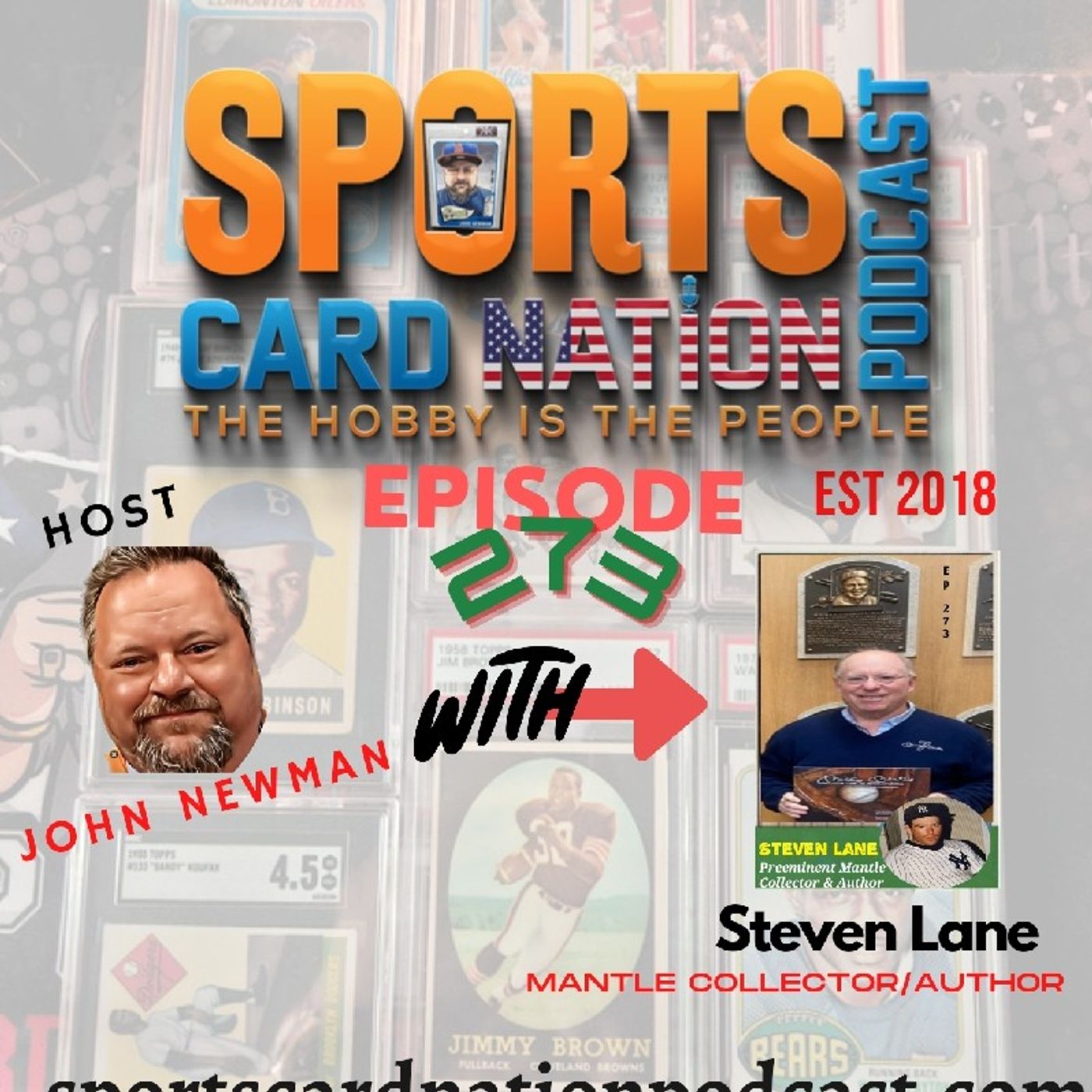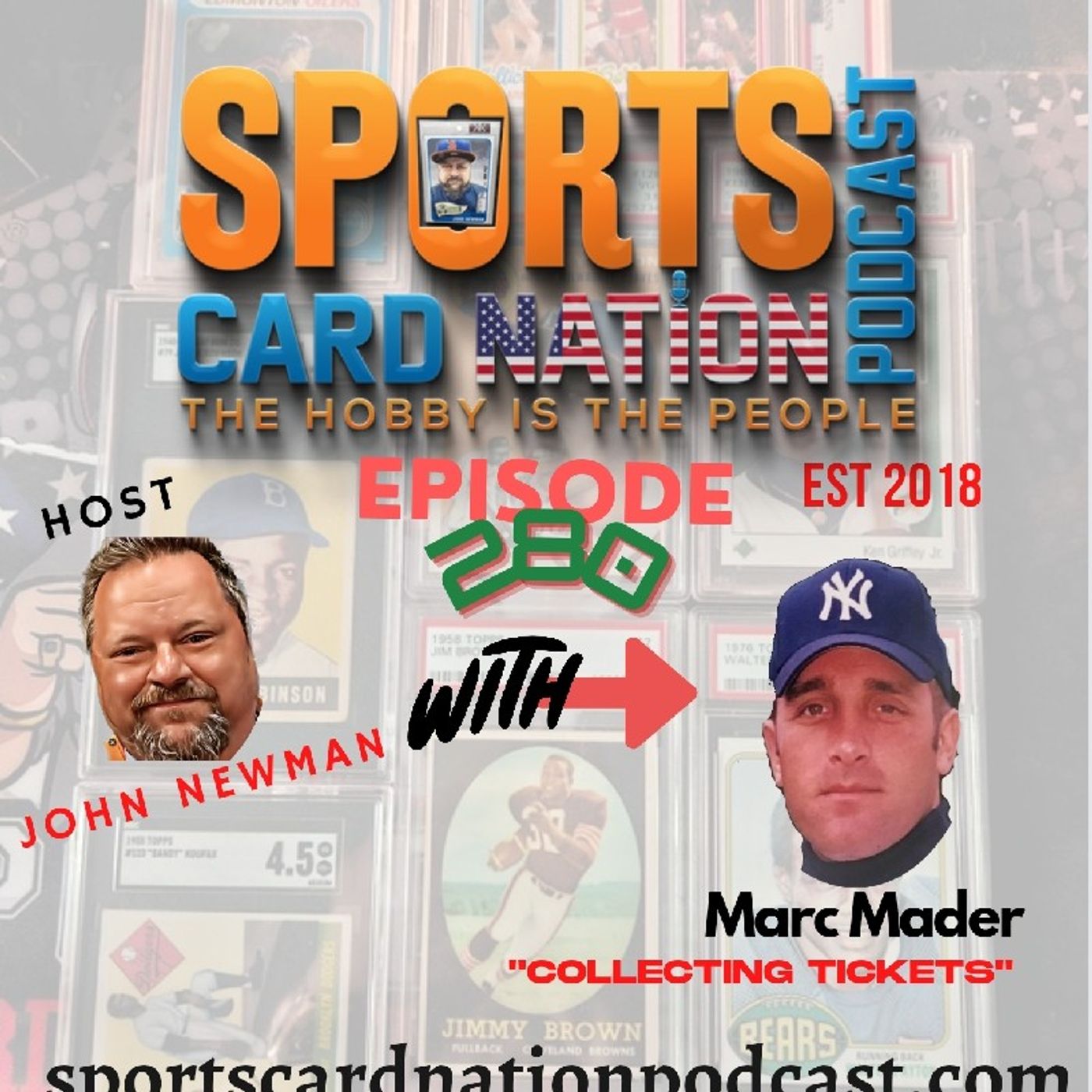Collective Dream w/ Lou Vigliotti E335
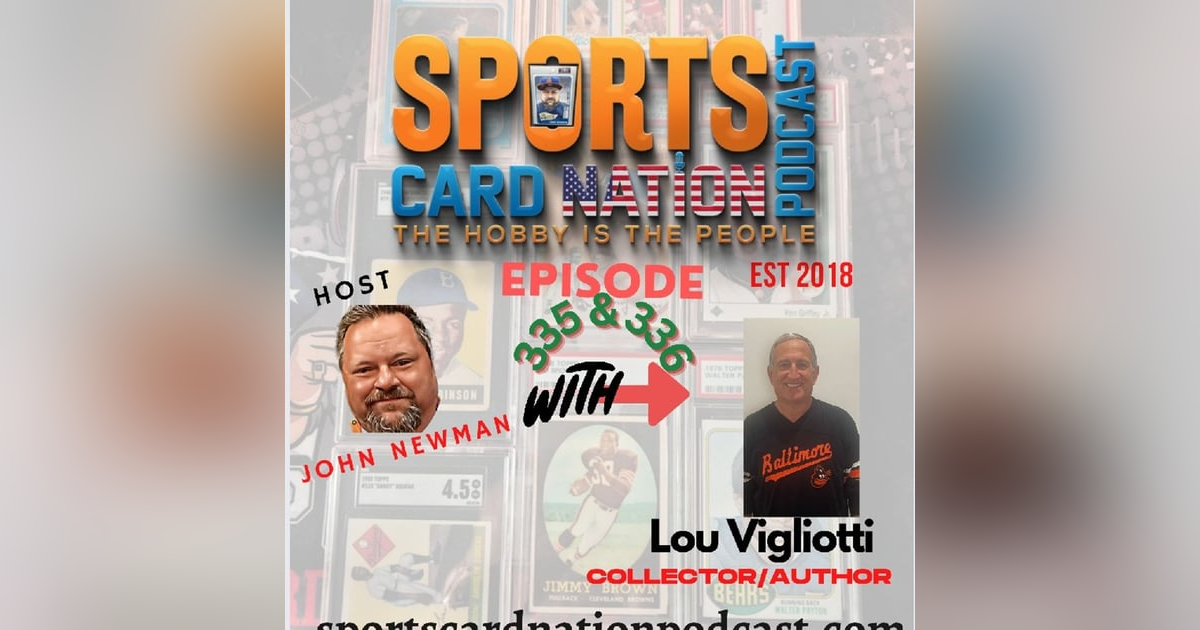
Lou Vigliotti is a card collector who has pivoted into autograph memorabilia. He also wrote a new book about his journey called "Collective Dream" he joins us today to share some behind the scenes on his collection and the stories of the acquisitions. Fun conversation!
Talking points on this episode may include:
*The Beginnings
*Mom you threw my cards away!
*Autographs hitting his radar
*Enjoying the hobby with his son
*75% of Autos are fake?
*Grail item
*The Lost Art of a beautiful signature
*Why a book and the process of writing it.
To save 10% off your whole order of supplies, go to:
https://www.thepennysleever.co...
=SCNATION
Use code "SCNPOD"
Follow us on Social Media:
Website:
https://www.sportscardnationpo...
.com
https://linktr.ee/Sportscardna...
Merch shop:
https://sports-card-nation.pri...
To eliminate pre & post-roll ads
https://www.spreaker.com/podca...
Sports guard Nations. Hobby is the people Wheely News and Interviews. It's you on number one soul Sportscarnation. Hobby is the people.
Sports Guardation. What is up everybody? Welcome to episode three thirty five Sportscardination. I hope everyone is doing well. Got a great guest on today's program.
Gentleman's name is Lou Vigliotti, and he's the author of a new book. His first book called A Collective Dream, and he's a card collector, but he also really got into autograph memorabilia and the book is kind of talks about his experiences, his collection, the interactions between him and the athletes that he acquired autographs from. And it's a great read. It's not a long book, about one hundred pages, and uh, you know, some some behind the scenes moments and we're going to talk about some of them right on today's program, but we're not going to talk about the whole book.
So, uh, check that book out. Could read it in a few days, maybe even in one day. And uh, you know, if you if you love the hobby and the autograph stuff especially, uh, you know, you'll find, uh you'll find a book very interesting and you know, you're not the only one whose mom threw out their cards. So we're going to take a quick commercial break and we'll be back with lou Hi.
Hi'm Isaac Calpert, a longtime card collector. I'm the co founder of the Penny Sleeper. My wife and I started the Penny Sleeper with a simple premise in mind to offer collectors top qualities of flies at fair prices. We offer a full range of hobby supplies and we'll get them to you fast.
Whether you're looking for a two hundred and sixty point magnetic for that oversized hatch card or a slew of semi rigids for your next PSA submission, the Penny Sleever has you covered. Shop now at the Pennysleever dot com and use the promo code sc nation to get ten percent off your first order. That's sc nation for ten percent off at the pennysleever dot com. The Penny Sleever, Top quality supplies, fair prices.
All right, real Happy to be joined by my next guest. He is a author of a new book called The Collective Dream, sharing his experience growing up up as a collector and in collecting autographs as well, and uh it's a great book. I've been privileged to be able to read it, and uh, once I started reading it, uh, it didn't take me long to finish it, because if I'm into a book that i'm reading, I consume it pretty readily and and got through it very quickly. Because very good and we're going to talk about that amongst other things.
But my guess, lou Vigliotti, thank you for joining us today. So kind of, you know, anytime someone comes out here for the first time, it's kind of the boring, uh start off question, but it's it's not really boring, but to some because most of the stories are very similar. But kind of how did you know the hobby start for you? When did it all start? So I guess it all started, you know, like a lot of little boys, if you will, collecting sports cards, baseball cards. I grew up a Yankee fan, and in the early sixties I was buying cards, very very young age, buying cards and trying to collect all the Yankees I could possibly get.
And I did have a lot. Of those, and you know, you know, probably saw in the book the story about how you go away to college and you come home and your cards are gone. And there's a lot of people that I've talked to that have read. The book that have come back to me and said, I can relate to that.
I see what's happened there. So it was starting with the cards, and then when my son was born, we started again with you know, continuing on with cards and so on. But as more and more of the card companies decided to come out with series one, two, three, four, you know, and it started out with you had Tops and Bowman or Flear, and then Upper. Deck came out and Panini and a bunch of others.
You know, it got to a point where I said, you know, the cards are just getting crazy, and so I picked up a couple of autographs at different shows and thought, this is a this is a pretty nice little hobby. To get into. And it became more of a passion, if you will, in terms of picking up these autographs at various shows, at various outings and so on and so forth. And the collection has grown now to probably close to four hundred items.
And but it's been it's been a true pleasure to be able to do this. And the people that I've met through all of this, the athletes and the sports icons if you will that I refer to. Yeah, it's it's been nice because they're just everyday people and when you get a chance to sit down and talk to them and not just get the signature, and they actually have a story behind them all. That's what really spurred.
On me going into doing the book Collective Dream. Yeah. And you know you when you say, you know, we all say, oh my mom throughout my card, that really happened to you, And you know, again not to I want people to read the book obviously as you do. But I like how you you were, like what what where? What? You know? You were like sort of flabberc acid and like, you know, figuring out maybe I can get these back.
It might not be too late to track them down. Mine went, you know, mine kind of I was fortunate they didn't get thrown out. Mine kind of went into a closet and didn't get thrown out. But that is the cut.
Like you said, a lot of people reached out the incident that hit close to home, the same thing you know happened to me. I was lucky in that regard. But you know, how do you you know, how do you restart? Is is it tough? Like when when that happens, and you know, like, hey, I still want to do this, like I just I went away to the school or whatever whatever, you know, whatever the reason is, Like you know, how difficult is it to kind of restart or not necessarily? Yeah, well, you. Know, after after they the good batch of cards was gone, if you will, you know, And then I graduated from college and I started picking up some cards, not the ones that I really lost, okay.
But others. And then when my son was born, you know, he got a little bit older, we started picking up cards, but there were more of the players and the time that he was growing up in not when I was growing up. And it was fun. I mean, opening the cards with him, you know, brought back the memories of when I was opening the cards.
And and it was it was nice. And then as we got a little bit older, as he got a little bit older, I should say, that's when we started. I started dragging him, if you will, to these various shows and he was able to meet some of these people and experience things that I didn't do as. A young kid in terms of the autographs and so on and so forth.
But it's it's pretty nice when you have a seven eight nine year old with you and you're taking him to these shows. The athletes seem to open up a little bit more, if you will, than they do for you know, people like you and me being you know, at our ages. But it's nice to see that they're interacting. And it gave my son an appreciation for the athlete.
And it not just the collection of the card or the autograph, but also the opportunity to. Learn about the actual player themselves. And I try to also do that in the book by putting in some statistics and someone behind some of these individuals that are that I have in the book, and I think it brings it a more personal. Level, if you will.
And I've had a number of people come to me and. Say, geez, you know, I knew so and so, but I didn't know all of the statistics behind him or all of the stats behind them are the personality behind the individual And that gave me a different appreciation. For it, Yeah, no doubt. And you know, yeah, an important point, right.
We see these guys and ladies on the athletic fields and services, and sometimes we forget that they're they're humans just like us, you know, in our minds. We sort of make them superhumans and they get sick and they have bad days and good days, just like us. And you know, in a lot of these cases, lou and you know this right with you're Willie May's and you're Mickey Mantles of the day. With the signings, they've stated like I make more post career signing and appearances than I did as a player.
You know, the contracts, you know, we know the contracts of today are astronomical. Back in the in the forties, fifties, in these sixties seventies, they weren't. Matter of fact, many players had jobs in the off season, whether it be insurance salesmen or whatever, or owned businesses and random businesses to pay their bills when they weren't in season. So it's a different it's a different error.
And I think you know, and I don't want to pay with a broad brush. I'll see if you agree with me on this. I think, I mean, every every player or athletes individual and has their own personalities. But I think the athletes of yesteryear, if you will, were more personable because they knew that that aspect was going to be a big part of their lives.
You know, even post career than today's. Like today's athletes don't even have to show up at a card show to sign autographs. They're getting paid to sign the cards that go into the backs, you know, the cards that yester year there was no autograph cards in pacts that came from you get you know, going to the game and getting them at the game, or a public appearance or just a chance meeting. You know, you were you saw them shopping or something like that.
And so these these signings and these appearances for many of these those era of players is a big part of their life. So I think a lot of them are more personal, where today's athletes it's like they don't need to do it. And you hear stories where like hey kid, I'm not signing or not today or or not even no response, or they come out of the clubhouse and they run out to they run to their car or the or the van taking them to the hotel and just try to you know, get away from signing. So you know, when you look at today's players and comparably speaking, it's it's it's a different you're dealing with a different short of thing.
You another great point you want to you may too. Is. I think they're more receptive to kids, right because of the innocence. Right, they see someone like me or you, while we may not actually be doing that, they just say, oh, this guy's gonna sell it an eBay or sell it to somebody else, or put it online with a price tag on it.
Now, kids can do that too, but that's not your first inclination as an athlete. So it's a great point you made. So, uh, I'll kind of you know two two prime question there kind of with the difference in in athletes today versus yesteryear and and and you know about you know, the perception of kids versus adults. Yeah, I think you're absolutely correct on that.
Uh, the the the older athletes, if you will, that had a second job, they had to have the second job. You know, one that comes to mind and not in the book, and maybe it's in volume two. Who knows is Art Donovan of the Baltimore calls Art is a is a a very personal individual. I mean you could talk to him.
He spent numerous times on I think the Letterman, David Letterman. Had I was gonna say he not that he he was on late night TV probably more than he was on the NFL grid Iron exactly, and he became a character and hit whenever he was on. That was like a point of TV because it was just you didn't know what was gonna happen. It was just you know what he was gonna say.
It's just gonna be funny. And he made like his he might be more known. And he was a great football player, don't make any mistake about it. He was an NFL great But I think more more people kind of know him from the off the field stuff and even some commercials he did as well than the on fields stuff.
But yeah, go help, go ahead, that's a yes. So so, you know, be living in Baltimore, and I had an opportunity to see already a lot and at different shows and at different outings Baby Ruth Museum galas and things like that. Uh, and he was always always talking and we had him one time. I remember having him at.
Our company function as a guest speaker, and we were in this very nice club and you know, everyone is this is back. You know, everyone's in a jacket and tie and Laraty comes in and he's got his tie on and he just kind of looks around and you know, he gets started, and he gets started in that in that Art Donovan of him, and all of. A sudden he just takes his time. He rips his tie off and he said, look, I know you guys are all wearing ties, he said, but I wear ties for two things, weddings and funeral and unless somebody's getting married or dying tonight, this has got to go.
And he just took it off. And you know, during the off season, Art had a couple of different business ventures, if you will, but early on he represented beer, Schlitz beer, and I don't remember you remember Schlitz beer, But that particular function that we went to at this nice club, he brought his own six pack of Schlitz beer and he said, hey, they pay my bills, I'm drinking their beer. And that was the kind of guy he is. But you could just.
Interact with him at any point at any time, whether you were looking for an autograph or just wanted to have a conversation. And a lot of times, and I've got a number of our signatures on helmets and footballs and stuff, but a lot of times I spent just talking to him just because telling the stories. And he would tell the stories of his you know, Jim Wessler and. Even Johnny and and all the other players that he that he was with, and it's just it's just great interaction.
And I don't think, and I may be wrong, but I don't think you'll see that today, the interaction with some of these players. Now, there are some out there. I agree there are going to be some, but some are just like you said, let me. Sign and get on and move on.
But he was one. Brooks Robinson is another one that probably the you know, you can get his signatures almost anywhere because he signed so much for people. But one of the things with Brooks is he would engage. He wanted to talk to people.
He was a people person. So that's kind of what I like about some of these. I'll call them the older athletes if you will. Yeah, two great examples there too, Lou with Ur and Brooks Robinson are Donovan.
You know, I think they really they got it so to speak, you know what I mean, The light bulb went on, like they knew they were athletes, but they also I think they wanted to be seen as just regular people, like, hey, I'm talented in my sport, I'm good at what I do on the football and baseball fields, respectively. But hey, I'm a person of the people too, like I enjoy just having a conversation about who knows what you know? And especially with our Donovan, it was who knows what you know? Could go in any direction? And you know, so two great examples there, and you're right, I think we're seeing less of that group. There's just less, you know, that personal experience with you know, a lot of these guys are just contracted and the cards that they're signing just get sent to their house and they just take a night with the door behind closed doors and just rattle off a bunch of signatures and then send it back to the manufacturer. I think that, in a sense gives a sort of that you know, they they're not envisioning.
Not again, I don't want to pay with a broadbrush, but I think a good percentage of them they're not envisioning. Maybe the smile of somebody when they open the pack and pull that person's autograph they lose sight of that, or people who come to the actual game to see them perform and play, maybe even specifically just for them, or one of the big reasons and. Time to hear from one of our great sponsors. But sports Gardination will be right back after that.
Hiron Sports Guards is your number one source for all your PSA and other grading submissions. Their elite status improves turnaround time. Heck, they even provide the card savers. Their tap rooms provide updates on all your submissions.
They also offer wax options and single cards to cover all the bases. Check them out on Facebook at Iron Sportscards Group or on the web at Ironsportscards dot com, or even give them a call at one eight seven seven Iron PSA. Rob's got you covered, Let's go. You are listening to the Sports Card Nation podcasts.
I think today's athletes also, I don't want to say if they work harder, but there's more technology wise, there's more training stuff, there's more equipment, so and it's very competitive, right how many times like you know a guy who have a great year and then two or three years later they're out of the league. Now. But that being said, you know, back especially with baseball, there were less teams, so there were less roster spots too, so it was competitive for different reasons even then. So I just think that you know, they just it's whether a player wants to make time for it or not.
And I tend to think the higher percentages is they rather not just do their own thing, and and I get it. But at the same time, you know, I think it'd be nice if they realize the people who are going to the games or their friends are kind of what's allowing those million dollar contracts to take place. And it's not just that I know their corporate sponsors and you know, but people go to the game, right it's not a cheap ticket anymore never, you know, never really was. But it's more expensive even even nowadays.
So I just wish, you know, I don't necessarily think they should spend three hours after a game either, but you know, rather than completely ignore that aspect, I wish they took it in account. And and like you said, many do, but not not all do. And I don't think you know my dad. You know, I'm a Brooklyn kid.
My dad grew up in Broken My dad was in abbotts Field. My dad would tell you he grew up in ebbitts Field. And he to the point where like he got even the note, like the players got to know him a little bit, so they shake his hand and say, hey, how's school going. Are you doing well? You're doing your work, staying you know, you're doing your studies and and and you know, like I had him on the show once to talk about like the difference between then and sort of now, and he got the unemotional he like started to cry and got choked up because two reasons.
He realizes it's not like that no more. And he realizes, like, you can't go back to those days, and yeah, it really is. And and you know, one of the other things too, is I think some of these athletes today when you get a signature, I've seen him where you look at it and go. Who is this person right who signed this? And and I go back to some of the older athletes, and I remember Bart Starr getting Bart Starr signature.
And how much time he took to sign his name. And I even said to him, I said, I said, you know, mister. Starr, I really appreciate you, know, your signature because you can read it. And he said, as I was growing up, my dad instilled on me be proud of your name, and when you sign it, make sure people understand what it is and who signed this.
And you know, I've always had that in the back of my mind, especially now being a collector and going out and getting. Autographs is what am I going to get? And I even instilled in my kids, not that they practice this, but I instilled on them be proud of your name. When you sign something, make sure it's it's legible. Everybody can see it and read it.
And they don't always do it. I try to do it, but I mean, I've seen some of these signatures on some of these these older players. If you look at Brooks's signature or Johnny Unitis's signature, and as I mentioned, bart Start and some of these others, lou Gerrick even going back and even Babe Ruth has he got a beautiful signature. Uh, they took time.
They took the time to sign it, and they're very proud of it, as opposed to just what I call chicken scratch on there. And you wonder, well, I just paid whatever dollars at this show to have this baseball signed by this individual, and no one's going to know what it says. So there's a little bit of a difference there going on too. Yeah, it's a lost start.
They don't even teach cursive anymore. Some of these guys, I really think, like you know, they don't know how to do it like they weren't. I don't want to make an excuse for him or you know, defend them, but I honestly think, you know, especially younger players, they didn't learn necessarily cursim in school the way me and me and you were taking and people older than us or before us. So cursive is becoming a lot start.
I don't know what that bodes for the for the future with autographs and signatures, but you make a great point. How many times you see a card come out of the pack and people will post it on social media and it's literally like one initial or if their name, if their first names, and E and their last names and F. It's just like in ean and F and it's sort of it's not even separate. It just kind of blending together exactly like you say, chicken scratch.
And really, I think it makes you appreciate the autographs that a person takes time to be lettled. I think you appreciate those even more when you see kind of what it's kind of transformed into, and you know the evolution of the autograph, and you know that times you know, usually with time, things get better, right, Technology gets better, innovation gets better. I think penmanship is going the opposite way it's it's going. You know, it looks more cave manash now than it did, you know, fifty sixty or or longer ago.
We're going in the wrong direction on the penmanship side of things. And like you said, you know for what some of these things cost, you know, and some of these who were talented athletes, just on their talent alone, what their signature is worth. But like you said, other than maybe if it's signed on a card or an eight by ten, you recognize the photo. But if you didn't have the photo there and just saw the signature, you'd have no idea who that was.
And it is kind of sad when you really think about it on that thing and I listen, I'll admit this. When I was a kid, I was a baseball kid, and I was pretty good and played off. But even as a kid, you know, i'd, like a lot of kids, you think you're going to make the major league. So I was practicing signing my autograph at eight ten years old.
So I like to think my signature is pretty good. I don't know who wanted other than if I'm excitying in the paper house or or something like that. But you know, as kids, we all think we're going to the major league. So I was practicing my autograph at a young age and uh uh based on that, and and maybe that's why my signatures, you know, not not too bad today.
But it's it's a different era and you know, it's it's what are you gonna do? Right, I mean it's it's uh, there's not much you can do about it except hope that you know, most still signed h legendly for for you, when did autographs really hit your radar? Like obviously we all start as as card collectors, but when did you know autographs like, hey, you know you mentioned about you know, when when the companies start making way too many series there is way too many companies. You know, was that it for you? And You're like, I'm just going to go in a different direction here. Yeah, that was pretty much kind of it. You know, I had picked up a couple of baseballs, and you know, I think one of the things that really jolted it got into place was was getting Willie Mays.
You know, I had going to a company out. In a golf tournament, and there was it was a beautiful golf course in San Francisco, and it was where the company would bring in football players, baseball players, and and they would put him in a forceme and uh, you know, unfortunately for me, I did not get to. Play with Willie Mays. But but it was at.
That function where I, you know, I knew he was going to be there, and I threw a bunch of baseballs in my golf bag, uh and approached him in a in a room and you'll you'll see the story in the book about when I approached him and him having a donut and walking into that particular room. I think he was in shock that I walked in because it was a private thing. I think the people around him were in shock because it was like, who is this guy? And I walk in with his baseball and pen and not even thinking twice and walked right up to him to get the signature. And then so that was great for me.
I mean, he had been retired twenty two years, but to have him be able to sign that ball. And then that evening there was. A charity auction for the Boys and Girls Clubs of San Francisco, and I bid on the Willie Mays jersey baseball and bat and I was successful in getting that. And I think having that jersey framed matted in this beautiful red oat frame and Hunt brought it back and got it back to my basement and put it up on the wall, I think that's really started.
When I looked at that, I thought, well, this is a really nice looking piece. I'd like the builder on this. And that's what started me going to various shows, the various shows that people have, whether it's in Philadelphia, Virginia or wherever it happened to be, or the national and getting signatures and building it up. And I think I mentioned I mentioned in the book that to me, these are really pieces of art.
I mean people collect art, they collect you know, sculptures or whatever. But when I get something, I'd like to be able to display it and look at it and there's a story behind it. And that's what really was the impetus to write the book was, you know, people would say to me. They look at something and they'd say, geez, you have some and so signature.
How did you get that? And I tell the story, and all of a sudden it started clicking to me. It was like, well, why don't I just put this down as opposed to just telling the story, to put it in print, And that's where a collective dream all of a sudden got started. And it's been and the feedback has been really good. I mean, people have enjoyed it.
They brought back a lot of memories to people, especially our. Ages, if you will. But even some of the younger people that have read it, as I mentioned, they didn't understand that there were statistics behind all these individuals and got to know these players. So but I think that's where I got started.
John was really when that really a maze thing, and I just started expanding it from there. Yeah, and you met, you know, tough piggybacking off what you said, right. They are works of art, just like the cards themselves are autographs are too, And it's I like we just spoke of I appreciate the long form version of the art and comparably speaking to the new form version of art, you know, And I think you know recent story that you know that that banana taped to a white canvas. Yeah, so I don't know what it sold for, you know, again that comparatively speaking to you know, a van goh painting that he spent how many hours you know, painting and like to taping a banana.
I think that's that's a good analogy to draw between uh yesteryear's autos and autos of today. But they are works of art UH in themselves. And and all right, that's gonna wrap up this week's episode. Thank you to Lou Vigliotti.
Great guy, UH great book, short, sweet but very interesting, a lot of, like I said, behind the scenes stuff with his interactions, and I think you'll enjoy it if you enjoyed today's conversation. We're not done. We're only halfway done. Part two next Friday, but right now we're gonna hear from our hobbies that people announce it, and then some closing thoughts and wrap up this week's episode.
Time hobby is the people Announcer of the Week. Hi, this is Danny Blad with Baltimore Sports Collectibles, and I love what I do because the hobby is the people. If you'd like to be the hobby is the people announcer of the week. Do have one have ORMP three file and send it to Sportscott Nation PC at gmail dot com.
Leave the good taken canoligy. For nearly fifty years, Sports Collectors Digest has been the voice of the hobby, bringing you comprehensive coverage of the sports collectible industry from industry news, auction results, market analysis, and in depth stories about collectors and their collections. Sports Collectors Digest has everything you need to know about the hobby. SCD is also your leading source for listings of sports collectible dealers, card shops, card shows, and the latest from the industry's top companies.
To check out all the latest news or to subscribe to the hobby's oldest magazine, visit Sports Collectorsdigest dot com or call one eight hundred eight two nine fifty five sixty one. Hobby Hotline is the hobby's only live, interactive call in show. Join some of your favorite hobby personalities every Saturday eleven am Eastern eight am Pacific to discuss the hottest hobby topics. If you miss us live, catch us after the fact on all major podcast platforms.
Follow us on socials at Hobby Hotline.









